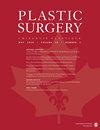美国和加拿大LGBTQ +整形外科医生的经验
IF 0.6
4区 医学
Q Medicine
引用次数: 0
摘要
背景:LGBTQ +群体在工作场所面临歧视,越来越多的证据表明LGBTQ +外科实习生受到虐待。本研究的目的是为了更好地了解LGBTQ +外科医生在整形和重建手术(PRS)中的经验。方法:从2021年10月到2022年11月,对美国和加拿大所有被认定为LGBTQ +的整形外科医生进行了一项基于网络的调查。问卷使用了经过验证的工具来评估“外向性”和微侵犯,以及言论和/或行为审查率和歧视经历。结果被测量为频率,并作为地点(美国vs加拿大)、性别认同(跨性别和性别多样化(TGD) vs顺性别)和培训水平(参加培训vs在培训)的函数进行分析。定性反应也被记录下来。结果:共有43名自认为LGBTQ +的人参与了调查,其中38人完成了调查(88%)。几乎所有(96.8%)的人都表示遭受过异性恋规范的微侵犯,36.7%的人表示受到整形外科医生的歧视,73.3%的人表示在整形外科医生周围会审查自己。TGD受访者比顺性别受访者更有可能遭受歧视(P <. 01)。三分之一(33%)的受访者表示,由于担心偏见和/或歧视,他们对在所在机构出柜犹豫不决。结论:LGBTQ +整形和重建外科医生在工作中报告了大量的微侵犯、自我审查和歧视,这些经历随着培训水平和性别认同的不同而变化。PRS应该努力消除这些虐待,教育其员工,并解决LGBTQ +在该领域代表性不足的问题。本文章由计算机程序翻译,如有差异,请以英文原文为准。
Experiences of LGBTQ + Plastic Surgeons in the US and Canada
Background: The LGBTQ + community faces discrimination within the workplace, with growing evidence emerging about the mistreatment of LGBTQ + surgeon trainees. The purpose of this study was to better understand the experiences of LGBTQ + surgeons in plastic and reconstructive surgery (PRS). Methods: A web-based survey was made available to all plastic surgeons who identified as LGBTQ + across the US and Canada from October 2021 to November 2022. The questionnaire used validated tools assessing “outness” and microaggressions, as well as rates of censorship of speech and/or mannerisms and experiences of discrimination. Outcomes were measured as frequencies and analyzed as a function of location (US vs Canada), gender identity (transgender and gender-diverse (TGD) versus cisgender), and level of training (attending vs in-training). Qualitative responses were also recorded. Results: A total of 43 self-identified LGBTQ + individuals engaged with the survey, 38 of which completed it (88%). Nearly all (96.8%) reported experiencing heteronormative microaggressions, 36.7% reported discrimination from plastic surgery attendings, and 73.3% censor themselves around Plastic Surgery attendings. TGD respondents were more likely to have experienced discrimination than cisgender respondents ( P < .01). One-third (33%) of respondents indicated that they hesitate to be out at their institution for fear of bias and/or discrimination. Conclusion: LGBTQ + plastic and reconstructive surgeons reported a significant amount of microaggressions, self-censorship, and discrimination while at work, and these experiences varied as a function of level of training and gender identity. PRS should strive to eliminate these mistreatments, educate its workforce, and address LGBTQ + underrepresentation within the field.
求助全文
通过发布文献求助,成功后即可免费获取论文全文。
去求助
来源期刊

Plastic Surgery
SURGERY-
CiteScore
0.67
自引率
0.00%
发文量
0
审稿时长
6-12 weeks
期刊介绍:
Plastic Surgery (Chirurgie Plastique) is the official journal of the Canadian Society of Plastic Surgeons, the Canadian Society for Aesthetic Plastic Surgery, Group for the Advancement of Microsurgery, and the Canadian Society for Surgery of the Hand. It serves as a major venue for Canadian research, society guidelines, and continuing medical education.
 求助内容:
求助内容: 应助结果提醒方式:
应助结果提醒方式:


